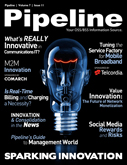|
|

By
Krzysztof Kwiatkowski
Introduction
M2M as a technology has been utilized for many years. It has even been used by various industries long before the term “Machine-to-Machine” was created.
Today the concept as well as its maturity differs from one country to another, and various industries are using it for various reasons. For example smart metering, which also uses M2M technology, is in different stages of development in different countries.
eHealth is something that many vendors and providers already have in their labs or even in their catalogs, however it is still blocked by some regulations or institutions and is not broadly used commercially.
But in some cases consumers are using M2M technology in their everyday life and don’t even think about it (e.g. when buying a ticket on a train or purchasing products from a vending machine)
Such machines are very often equipped with dedicated M2M SIM cards and devices which are part of a complex information exchange chain.
One very promising market – not yet affected by regulators – is consumer electronics. According to a research report from Berg Insight, The Global Wireless M2M Market - 3rd Edition, AT&T will become the first mobile operatorto reach 10 million M2M subscribers at the beginning of this year. Everything thanks to customers in consumer electronics.
Many devices and gadgets, such as an
e-reader, digital camera, or printer,
|
|
The race for a share of the M2M revenue pie is happening now. |
|



(source: European Tele-communications Standards Institute
[ETSI]). And this vision sounds quite
realistic.
It’s safe to say that the real development of M2M technology and its market is still to come. But the race for a share of the M2M revenue pie is happening now.
"Great things are done by a series of small things brought together"
-- Van Gogh
Only some of the industries using M2M technology have been mentioned. During various M2M events there have been a lot of discussions among small and medium companies using M2M for running quite interesting niche businesses, often very successfully.
|
|
|
Differences between traditional and M2M subscribers
The difference in characteristics of traditional and M2M subscribers is significant, Just as the differences between smart phone users and connected devices is huge.
The traffic generated from M2M is generally not as big as from smart phones, however for some types of services it can be still quite significant – e.g. CCTV requires permanent video transmitting sessions. But the average cost of network usage per M2M subscription is 0.60$, compared to 5$ for a traditional subscription (according to Current Analysis, Best Practices in M2M: The Operator Perspective report, published in 2010).
Of course, differences in ARPU are significant. According to Current Analysis, this is $50 for wireless services and $3 for M2M. The profit per subscriber is $24 and $1.50 respectively. The margin for M2M services can reach 50%, while wireless services reach 44%.
The conclusion from such analysis is obviously not one where operators should stop thinking about traditional subscribers and focus on M2M. However, looking at the presented figures, it seems that it is possible to achieve quite a good margin on M2M services. Adding current trends to the observation – the saturated mobile market and the growing M2M market – the potential of the latter seems to be very attractive for operators.
If we look at the exact potential of M2M, as it is presented in some analyses and predictions, we find that only in Europe will the market grow from less than 6,000,000,000 EUR to 12,000,000,000 EUR in 2014 (Source: IDATE, The Machine-to-Machine Market 2010-2014 report, published in 2010).
The question is, who will get the biggest share of the revenue pie?
|
|
|

may
come with an embedded SIM card
providing connectivity for various
purposes. Each one of us has more
than one of these devices. Estimates
say thatthe possible number of devices
which can be connected is five times greater than the amount of humans
|
|

Such companies are also important drivers of M2M business. For them, M2M technology is mainly a source of information that is delivered to them using certain devices. They don’t want to think about continuous interactions with a mobile operator, managing SIM cards, devices, etc.
|
|
|





